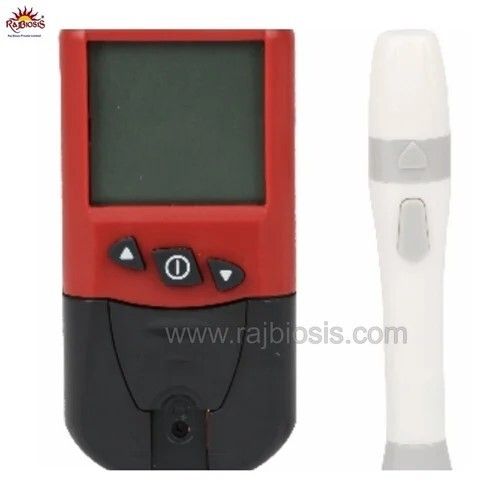 08045816368
08045816368

Sahil Hemoglobin Meter
Product Details:
Sahil Hemoglobin Meter Price And Quantity
- 10 Piece
- 1400 INR/Piece
Sahil Hemoglobin Meter Trade Information
- 1000 Piece Per Day
- 1-2 Days
- Yes
- Sample costs shipping and taxes has to be paid by the buyer
- All India
Product Description
A hemoglobin meter is a medical device used to measure the concentration of hemoglobin in a person's blood. Hemoglobin is a protein found in red blood cells that carries oxygen from the lungs to the rest of the body and helps transport carbon dioxide back to the lungs for exhalation.
The measurement of hemoglobin levels is crucial in diagnosing and monitoring various medical conditions, such as anemia, polycythemia, and other blood disorders. Anemia, for example, is characterized by a lower-than-normal level of hemoglobin, which can lead to symptoms like fatigue, weakness, and paleness.
Hemoglobin meters are commonly used in healthcare settings, such as hospitals, clinics, and laboratories. There are different types of hemoglobin meters, including point-of-care devices that provide rapid results and more traditional laboratory-based instruments.
Some hemoglobin meters use a technique called spectrophotometry, where light is passed through a blood sample, and the absorption of light by hemoglobin is measured. Others may use a method called electrochemistry or other technologies to determine hemoglobin levels.
It's important to note that the accuracy and reliability of hemoglobin meters can vary, and results from these devices are often confirmed with more comprehensive laboratory tests for confirmation. If you have concerns about your hemoglobin levels or related health issues, it's advisable to consult with a healthcare professional for proper evaluation and guidance.
Hemoglobin Meter FAQ:
Q. What is a hemoglobin meter?
Ans: A hemoglobin meter is a medical device designed to measure the concentration of hemoglobin in a person's blood.
Q. Why is measuring hemoglobin important?
Ans: Hemoglobin is crucial for transporting oxygen throughout the body. Measuring hemoglobin levels helps in diagnosing and monitoring conditions like anemia and other blood disorders.
Q. How does a hemoglobin meter work?
Ans: There are various technologies used, including spectrophotometry and electrochemistry. These methods involve measuring the absorption of light by hemoglobin or utilizing electrochemical reactions to determine hemoglobin levels.
Q. Where are hemoglobin meters used?
Ans: Hemoglobin meters are commonly used in healthcare settings such as hospitals, clinics, and laboratories. There are also portable and point-of-care devices used in various medical settings.
Q. What are normal hemoglobin levels?
Ans: Normal hemoglobin levels can vary based on factors like age, sex, and health status. In general, the normal range for adults is around 12 to 18 grams per deciliter (g/dL) of blood.
Q. What conditions can be identified through hemoglobin measurements?
Ans: Hemoglobin measurements can identify conditions such as anemia (low hemoglobin levels), polycythemia (high hemoglobin levels), and other blood disorders.
Q. Are results from hemoglobin meters accurate?
Ans: While hemoglobin meters can provide rapid results, the accuracy may vary. Confirmatory tests in a laboratory setting are often recommended for precise measurements.
Q. How is a hemoglobin test performed?
Ans: A blood sample is typically collected from a vein, fingertip, or earlobe. The sample is then analyzed using the hemoglobin meter to determine the hemoglobin concentration.
Q. Can hemoglobin meters be used at home?
Ans: Some portable hemoglobin meters are designed for home use. However, it's important to follow the device's instructions carefully, and results obtained at home may need confirmation from a healthcare professional.
Q. What are the symptoms of low hemoglobin levels?
Ans: Symptoms of low hemoglobin levels (anemia) may include fatigue, weakness, pale skin, shortness of breath, and dizziness.
Q. Can factors like diet affect hemoglobin levels?
Ans: Yes, diet can influence hemoglobin levels. Iron-rich foods, vitamin B12, and folate are essential for hemoglobin production.
Q. Is a hemoglobin test the same as a complete blood count (CBC)?
Ans: A hemoglobin test is often part of a complete blood count (CBC). A CBC provides a broader picture of the blood, including red and white blood cell counts and platelets.

Price:
- 50
- 100
- 200
- 250
- 500
- 1000+







 Send Inquiry
Send Inquiry Send SMS
Send SMS Call Me Free
Call Me Free
